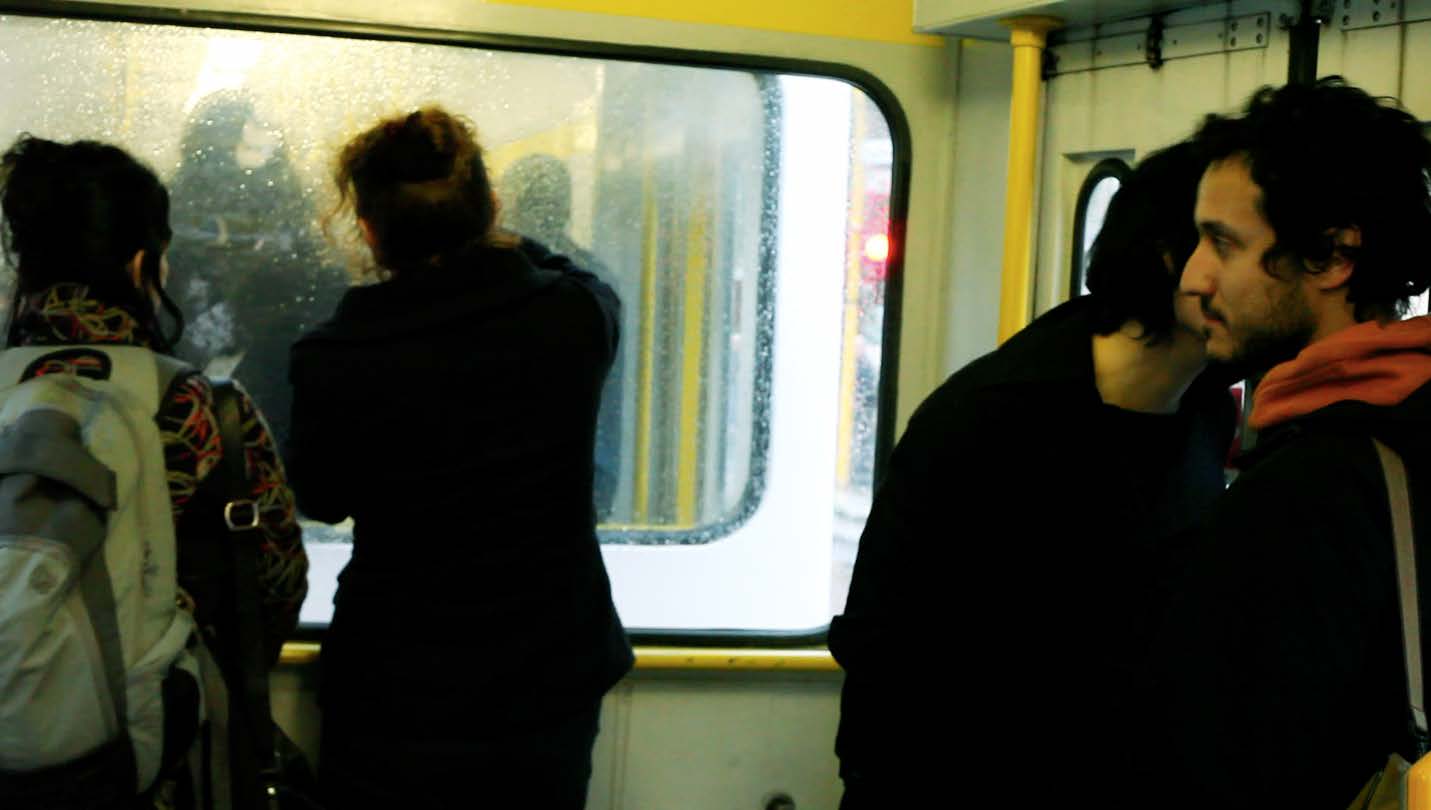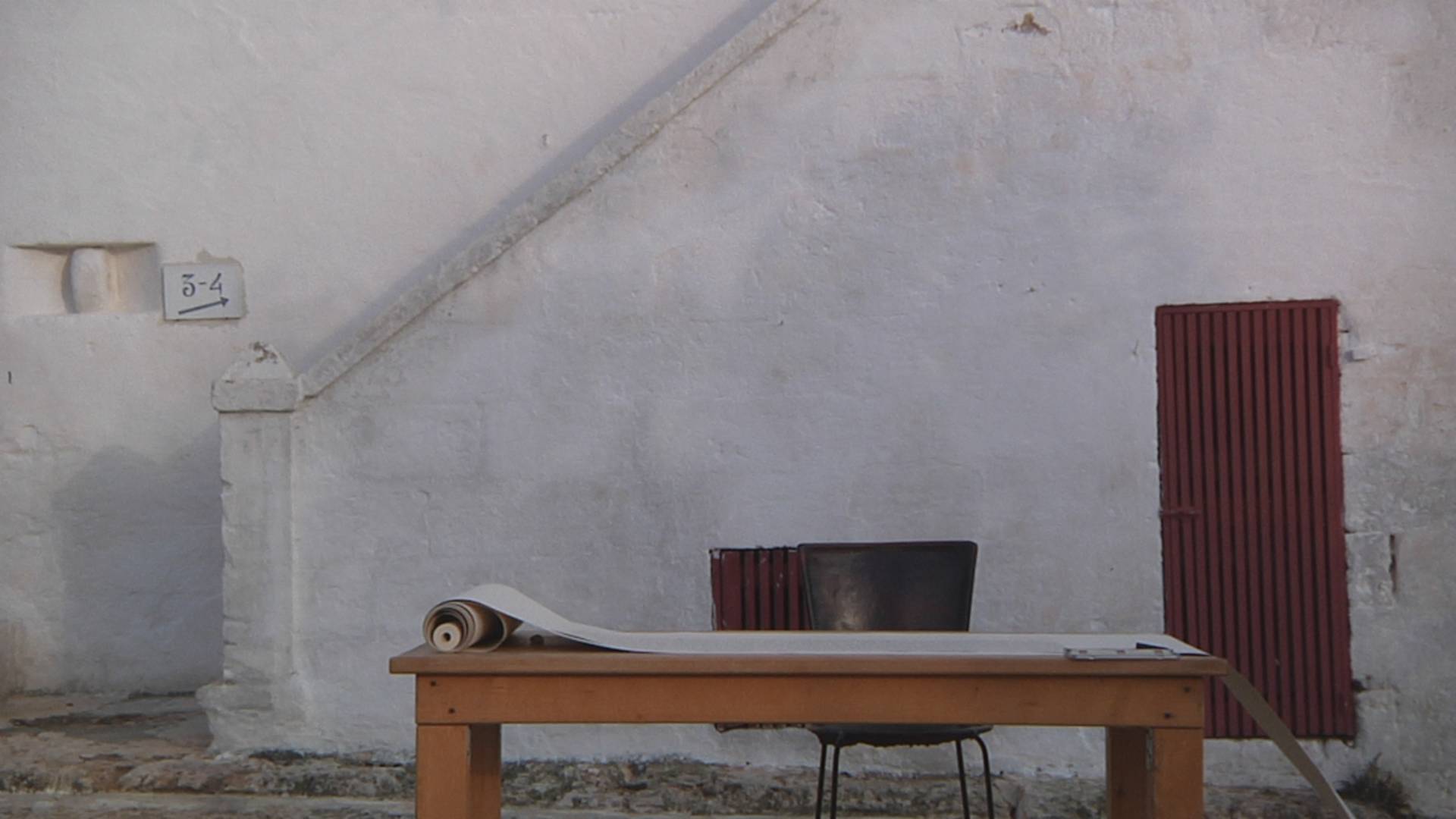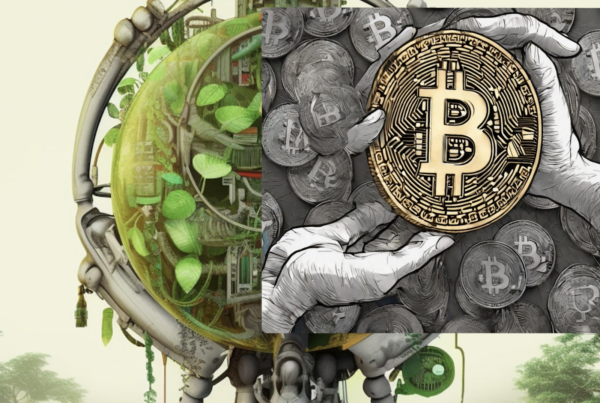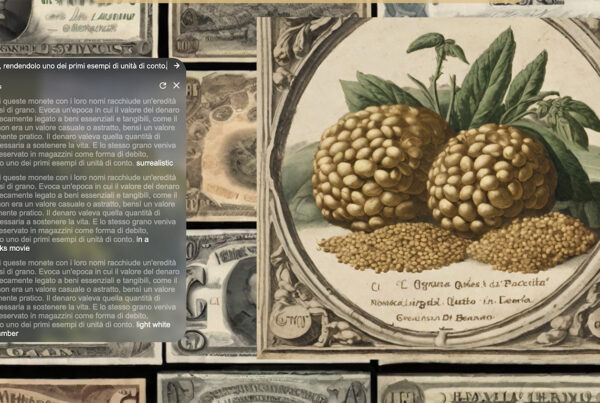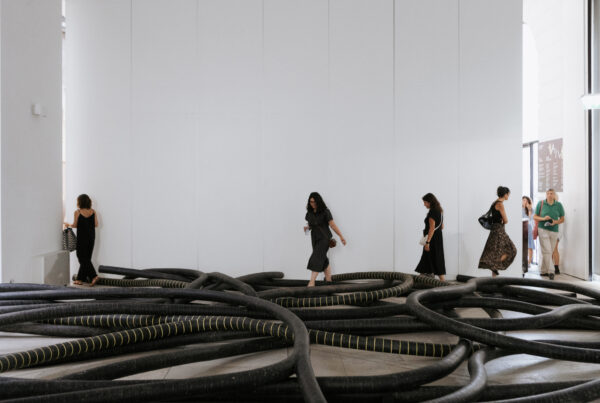This conversation was published on Idea #40 in 2012.
Vlad Morariu: I would like to talk about three of your works, the Machine That Produces Time, The Commuter and Cheek to Cheek. I became interested in them because I think that they produce a very strong resonance with what Deleuze and Guattari would call “machinic assemblages”. Of course, there is more to them than a mere use of technical devices, of which there exists a certain reflection in your works; I rather refer to the manners in which your performative acts disrupt structures and flows of daily life, and concatenate elements of different regimes: writing, letters, and paper, social arrangements, bodies, and subjectivities.
Valentina Vetturi: Deleuze and Guattari have come up with the concept of the desiring machine. I think that in these works my own subjectivity was acting as a sort of a desiring machine: my desire was to create a leap, an interruption in the processes of everyday life. In my performances I partly act mimetically within the environments of everyday life, but at the same time I am always trying to create these shifts. This is the point of my works. And I remember that Deleuze said something like “Let your desiring machine be alive”. Performance has to do with a will to act, and I am interested in activating doubts. In all the works you mentioned, what is constructed operates with different meanings. The work is created trough a strict dialogue with the environment where it takes place. In the Commuters I was trying to share the conditions of workers traveling from one periphery neighborhood of Rome to the city, whereas in the Machine that Produces Time I was reflecting on the concept of luxury, of that was is produced and offered in a place like the Masseria Torre Coccaro in Savelletri, Puglia.
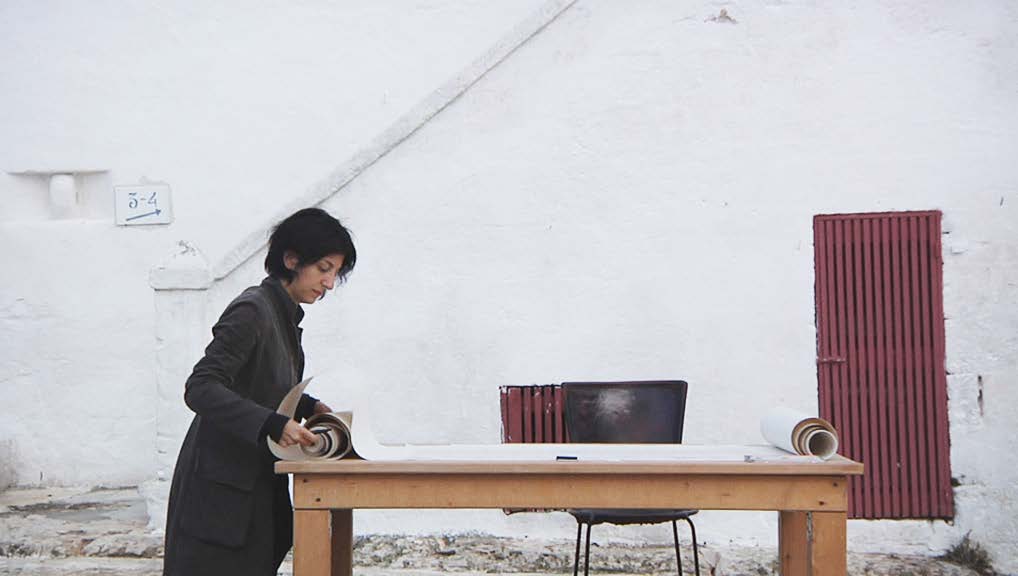
V.M. What is a Masseria?
V.V. A fortified farm in the countryside, a typical structure in Puglia as in Sicily build during the Spanish domination that now is transformed and used as a five stars luxury hotel.
V.M. And what kinds of work are people doing there?
V.V. According to me, people there are working in order to produce Time, free time, for clients. Time has become a luxury today and the Masseria is a temple of free time, a temple of a possible idleness. The clients go there to find a break from work and everyday stress. I was there because I was invited in a residency, and I spent the first ten days as a guest of the resort, trying to experience this luxury, to understand what luxury is today.
V.M. As I visited the Masseria myself, I had a very strong feeling that everything is, indeed, too perfect to be real.
V.V. There are forty rooms and a staff of eighty people, at minimum, but they are invisible, you don’t see or hear them. I was living there for ten days without even imagining this amount of people, and as soon as the owner told me about it I understood that I found the key of the Masseria. I was living in a machine, a very sophisticated but totally silent mechanism. A social machine that was producing time: I decided to make it visible. But this presupposed investigating its human components, and I found it necessary to meet all these people. However, since I was a guest, it was not easy to obtain their trust. Although I was supposed to stay there for three weeks, seeing all of them took me one month and a half. In the end I talked to every person that made up this collective body with no hierarchical distinction. The concept of time in itself became my main point of interest. Therefore, in talking with them I started to describe this image of a Machine that produces Time, and, I have to tell you, that they felt a little bit displaced. The starting point of our dialogues was “What is then time for you?”, the first line from St. Augustine’s famous fragment from Confessions, which reads “If nobody asks me, I know it; if I want to explain it to those who ask me, I don’t know it anymore”.
V.M. And then, your question about time needed time to find its answers?
V.V. An unusual question has the power of creating a certain intimacy that otherwise is forbidden to a stranger. I was still a stranger there, a client, though one asking them about time. Most importantly, I went there to interrupt these people while they were working. I didn’t make any appointment, I was going there, presented myself, and asked them about time; with some of them I would talk for hours, with others even for whole days, while with others only for minutes. Their available time was decisive. But what was really interesting is that by the time I had already talked to a part of them, word about my presence was spreading from mouth to mouth, they were asking each other what they answered to my questions: at the end they started to talk about time without me. In a way, this question generated a process which I was glad to lose control of.
V.M. Tell me about their answers and about the very process of assembling them in your work.
V.V. There were many thought-provoking answers. I discovered an unexpected willingness to talk about fragments of life. One woman from the laundry answered that time, for her, is 48 years of marriage, five kids and eight nephews. Some of them said that time is lack of work. This type of answer came especially from those working in the kitchen, because their labor was taking place under a lot of stress. On the other hand, women working in the laundry or some of the waitresses in the rooms said that they had no time, because they were working both in the Masseria and at home for their families. With men it was a bit different, for them the distinction between working time and leisure time was clearer. Then there were more – let’s call them philosophical answers, concerning the perception of time, some even said that time is a constructed concept, that we invented it, that it doesn’t really exist as such, that it is useless to talk about time in itself, that you can understand it only when you measure it. Last but not least, I also discovered that for some of them time was linked to migration. When you are a waiter for a five stars luxury hotel you have to have a certain level of professionalism, you have to know many languages, you have to serve in a certain way, you need to know how to talk with clients, how to have conversations. All these people learnt their profession by working in different parts of Europe, some of them would come to work for the Masseria only for a number of months a year, whereas others simply decided to come back for personal reasons. So I collected stories about times of wandering through the continent as well. As for my work process, I didn’t record any of their answers, or take any pictures; I just took notes at the end of the each day, trying to remember what I have been told. These were filtered during the performance, which took place in the courtyard of the Masseria: it was the public space of the area. For one week I was writing on a 20 m long paper scroll roll, I was writing what I remembered about their answers. The video following this performance has a straight composition, just a few elements which don’t include me. There is there, nevertheless, a sort of eternal repetition of an inner moment about life which goes back and forwards, like a still image
V.M. You were invited at the Masseria as an artist: did you manage to break this circle of privilege when working with people?
V.V. This was something on the line. I don’t think they perceived me as one of them. I had a privileged position as an inquirer and a listener. I think that the workers started to perceive me differently, or something changed when they saw me writing for one whole week, because they had seen me asking questions before, something that they could perceive as not a hard work, whereas writing seemed to take a lot of energy. However, for me asking questions was harder than writing, because writing could be physically stressing, though less emotionally upsetting. For me it takes more energy to try to enter in someone’s private sphere of life: it needs a lot of training that you have to do with yourself. It implies sharing, because otherwise you cannot have a real discussion. I shared the process of work with them, they were always aware of its progress, became involved and started to help me. At the end they all somehow found an excuse to come and see me performing. The performance was about what I was remembering from the dialogues I had with them. I was writing down in a peculiar order: name, then time, then question and the answer. It was an excerpt of their answers, of what I thought it was interesting in their answers. There was this filter which was my memory and my interest. Everybody knew I would make mistakes or misunderstand something. But at least I remembered all their 80 names.
V.M. One constant in your works is the use of writing. What is the relationship between the performative body, writing and time as experienced by others and by yourself?
V.V. Writing was a way of registering the time of my work: this is why I decided to write for one week on this long scroll of paper. I consciously sought to feel the tiredness of work. I thought that when I work with workers I need to do something performative, that takes a lot of energy, something that makes me feel tired. In a way this puts to test another machine, the machine of the body, and its capacity to perceive time. Thus, there is a direct connection between writing and the body. This is why I enjoy Augustine’s fragment, because he is concerned with the perception of time: rationalizing the question of time might not provide a satisfactory answer, whereas there is this other type of knowledge, obtained through the body, a sort of filter for time. While I was living as a client I was totally displaced and so I realized that I had started to perceive time only by physical means, like changes in daylight: a sort of body reflection about time. It was the first time I didn’t perceive time in terms of work – finishing this, starting that – but I was dealing only with light and the great silence of the Masseria, which was really alienating. But going back to writing, it is developed on two levels: it is not only a way to deal with memory, to create something readable, but it is also a way to create a visual sign. My aim was not only to create a story: the scroll of written paper registers the machine as a sort of a musical score. That’s why there exists also an audio of the performance. While I was writing I was also pronouncing words, as a way of learning the alphabet of the place, like children do when learning letters while pronouncing them.
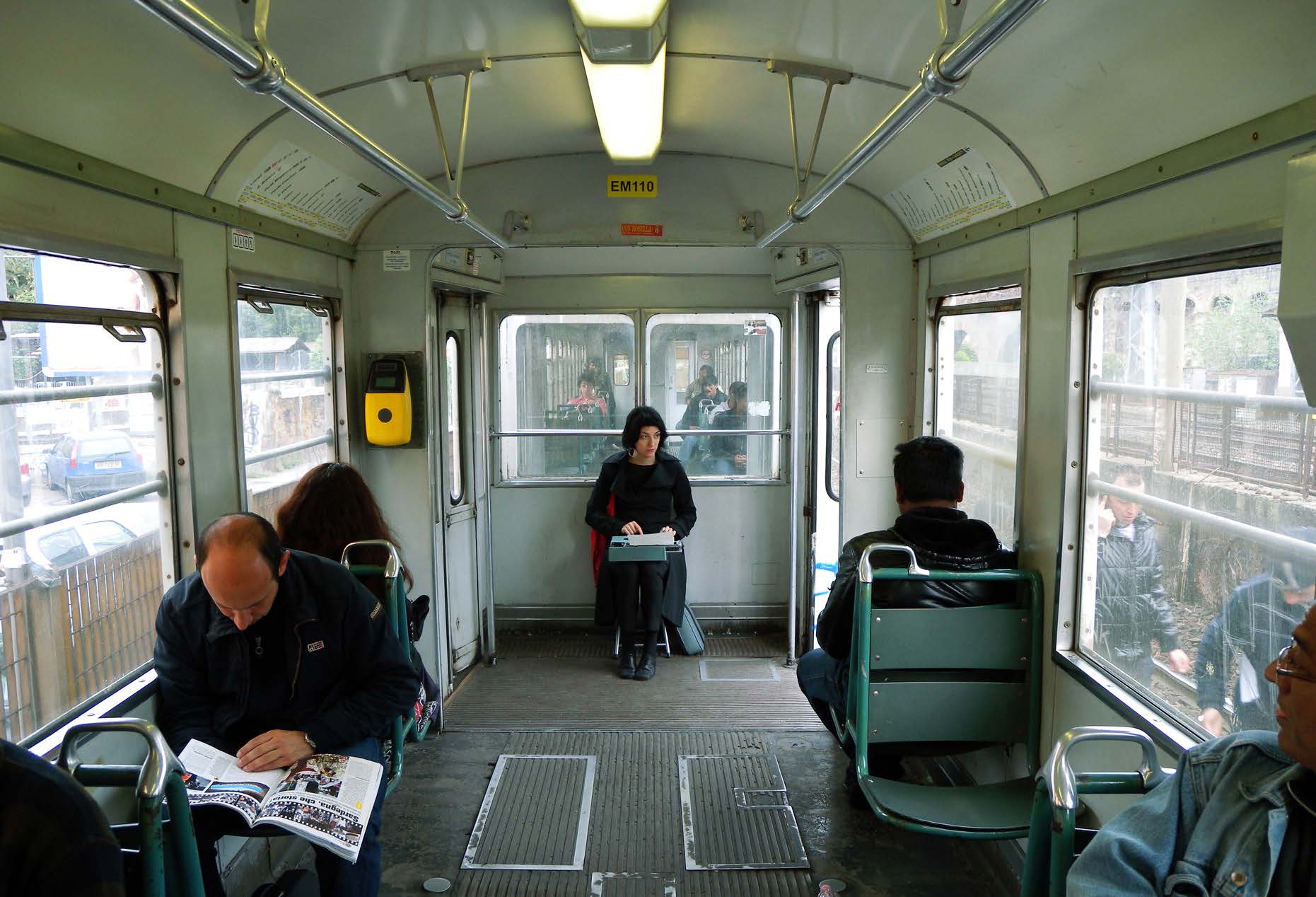
V.M. This is interesting, and I feel it necessary to go back to Deleuze and Guattari. Among the machines capable of breaking closures they were mentioning musical scores, algorithms of logic, or algebra, art or the language of theoretical physics. In a way they are all diagrams or maps. Their peculiarity lies in the fact that they constitute sites of production, their purpose being not to represent thought, but to generate thought. And I think that your artwork becomes a sort of a map, of a diagram, of an alphabet, which functions in the same logic, because it doesn’t simply represent the machine of the Masseria. It exceeds it, becoming something of a machine in its own right; it produces its referents, generating its effects and its expectations. And I think that this is true for your other two works, The Commuter and Cheek to Cheek, which were realized following a residency in the Tor Pignattara neighbourhood. To the already known assemblage of workers-body-writing there is, nevertheless, a new instrument intervening, the typewriter. How did you get along with it?
V.V. First of all, the typewriter functioned as a sort of protection. I was again privileged: I could distinguish myself from the others. On the other hand, it helped me escape from a progressive feeling of alienation that I felt during the performance. For eight hours a day, during seven days: I was a commuter, I was endlessly travelling from the Roma Termini station (the main train station in Rome) and a far away station in a neighbourhood, Tor Pignattara. I would get on and get off, again and again, travelling back and forth. I wanted to achieve a correspondence between the physical time spent in this train, and a continuous stream of writing. I gathered and combined thoughts in my mind with fragments of conversations that I heard in the train, words from the newspapers read by people next to me, parts of bodies coming and going, I was writing about people’s postures, about faces, hands and smells, about my own sickness and my own loss of time, about the wait for the end of the working day, and about the conversations held with people interested in what I was doing there. I was also writing about what I was doing, reflections about the rules of a performance, about what a performer can or cannot do, about a public space reproduced in a closed space.
V.M. So again, I see writing operating as a compensatory remedy. It starts by registering what is around and then, as it were, sets the mind free.
V.V. You see, travelling backwards and forward, everyday, for the whole of your life can become a ritual. Rituals are indeed repetitions of past events. But I think that the typewriter introduced a difference, while initiating another ritual, my personal ritual. I would get in the train, open the bag, place the machine, write, roll the coil, release the slider, place the sheet, write, write, write, close the bag. The typewriter became the key operator, as I wanted to have a written outcome while I was doing the performance. I couldn’t carry a printer with me and I couldn’t’ do handwriting: typewriting is different than hand writing or computer writing because you cannot change anything of what you’ve written. It was the first time I was using a typewriter and I could afford the luxury of doing mistakes while typing. Since I was on a moving train, many imperfections added to those mistakes. I enjoyed working with these flaws, with these uncontrolled interruptions and imperfections: the ink would often run out, the machine would stop working all of the sudden, it would for example fall down because of the moves of the train, or even within the 45 pages that resulted, spaces in the writing which were dictated by the train speed or bends. And there was the noise of the machine, a sort of music that a machine does, and again the idea of a score came out. I was producing signs and a kind of music.
V.M. So let us reconstruct this image: among those 35.000 people travelling daily in this train, on their way to work, there is an artist with a typewriter, which seems to have landed there from a different century… This must have raised some eyebrows…
V.V. I used an Olivetti typewriter from 1978, a model used by journalists that were doing field work. For sure, it also has a certain aesthetic and historical load and I wanted to create with its help a shift – using something which is not from our time: otherwise I would be just a woman with a computer in the train. I wanted to distinguish myself in a subtle way from the others. I am very sympathetic with Jean Luc Nancy’s idea of the intruder, I saw myself as an intruder which breaks regular flows. In L’Intrus Nancy writes that “Since moral correctness assumes that one receives the stranger by effacing his strangeness at the threshold, it would thus never have us receive him. But the stranger insists and breaks in. This is what is not easy to receive, nor, perhaps, to conceive”. So, on the one hand I wanted to experiment this condition of the commuter, that I call the palindrome condition. – A palindrome is a word or a verse that reads the same backward or forward. – I would say I was multiplying palindromes, several panlindromes a day for a whole week, which means going from A to B and from B to A, but neither A nor B, nor the path between them being really important. I was not able to count how many times I went back and forward. I totally lost the perception of the time I spent in there. On the other hand, I was intruding, breaking the palindrome, I was breaking in, and I was testing people’s reception.
V.M. Your works seem to take pleasure from this translation of time through the means of your own body. And you seem to enjoy pushing the experiment to the limit.
V.V. Before doing this performance I was reading sociological literature concerning the condition of the commuters, and some sociologists are describing this as a schizophrenic condition. I don’t know if this was because I read this literature before, but I felt this strongly, not necessary schizophrenia, but a strong feeling of displacement between A and B. B, which is work, is the place which you don’t necessarily desire, but A, which is home, becomes also a place that you don’t desire. This is valid especially for the foreign women I encountered in the train: hearing them made me understand that their work presupposed taking care of old people, which is always difficult. I spotted signs of absence on people’s faces, they were seeing people and objects in the train but really not seeing them, and some of them were so alienated that they just looked at me and were totally not interested. Since the first day I was just looking all around to learn what was going on, and observed that I, myself, was starting to lose interest, just like them: and so, for me, the physical travel became rather something like a mental travel.
V.M. What kind of reactions did you encounter?
V.V. Most of those who got in contact with me remained quite indifferent after looking puzzled at me, for a while. But then, again, many were annoyed by the noises I was making. There was even a woman that started to scream at me because she didn’t want to hear the noise of the machine. She asked me “Why don’t you have an office? Why are you staying here?” Another woman asked me to hand in aspirins to all the passengers, and I was also accused of showing disrespect to people. But there were also people telling me about how they used typewriters in the past. Because this was the first time I was using a typewriter, a man suggested to me how to use it in a proper way. I was doing so much noise because I was not using it properly, and he showed me how to make less noise. However, my policy was not to approach anyone. If someone decided to approach me, I answered. I also experienced embarrassment. What I was writing was a sort of diary, which is private. But because I was using a typewriter my writing became public, and people could read it as I was typing it. And sometimes I was writing about them: the paper became a sort of mirror for us.
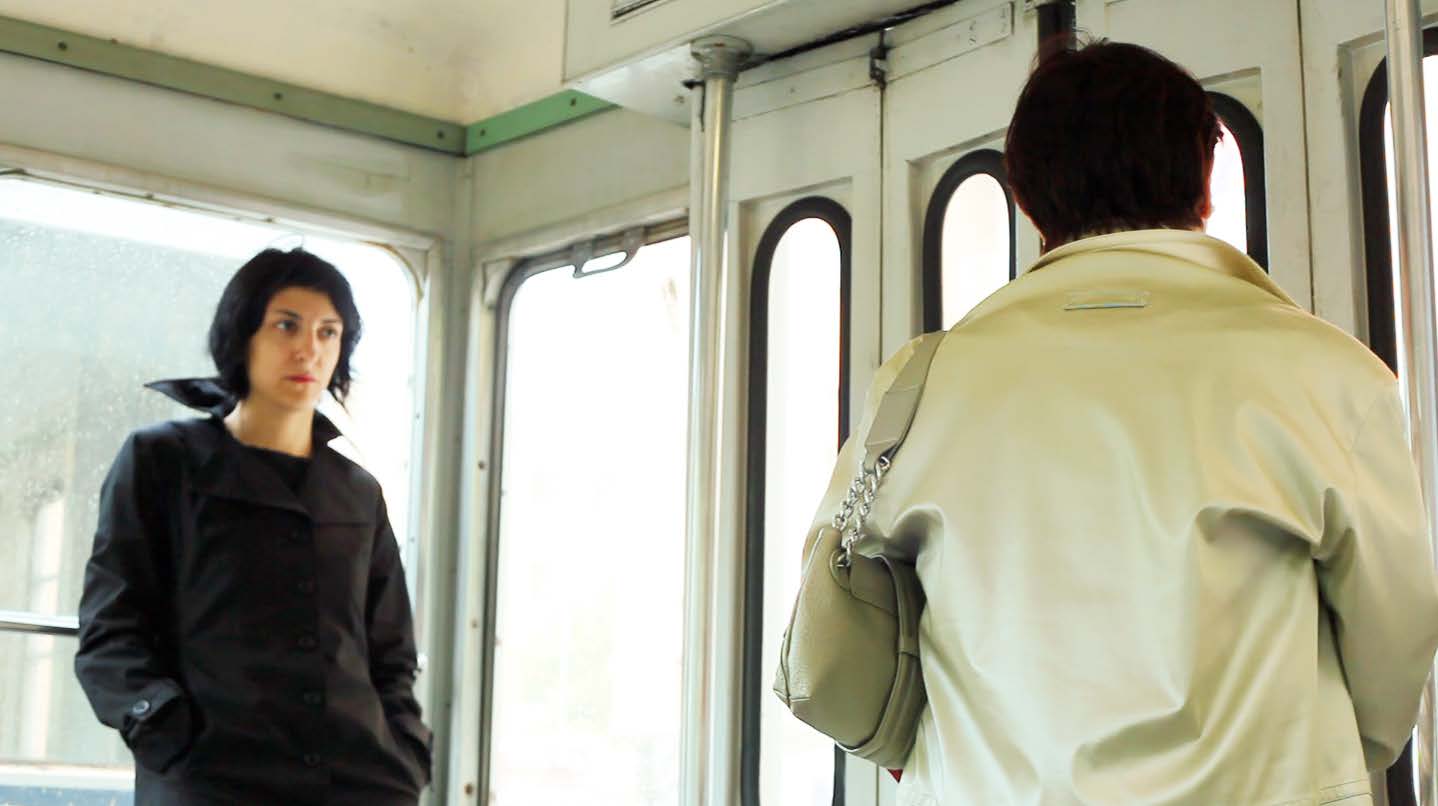
V.M. Nancy writes that if the intruder is placed at some distance, on some sort of threshold, because of social conventions or simply because of political correctness, his presence there speeds up, nevertheless, an insistence to be taken into account. Cheek to Cheek is not simply presence, it is the conscious taking over of this insistence.
V.V. Cheek to Cheek was born out of the feeling of estrangement that I felt in the train, that’s why I decided to look in the eyes of people and to try a sort of appropriation. To touch their cheeks with my cheek. I started to study the commuter’s cheeks, examining their curves, their skin, imagining the possibility of approaching them, imagining the mixture of pleasure and fear while doing the action.
V.M. Cheek to Cheek operates upon this artificial private space that people create in the train. People always manage to construct a space where they feel safe. But in this case, you invade their circle of safety and there would be nothing protecting passengers, just like there would be nothing protecting you either, because you cannot calculate reactions.
V.V. In this kind of train, the private space is always invaded. There is always a sort of contact, as you can always feel the body of somebody else – the knees, the hands, etc – . But people pretend that they don’t feel it. I wanted to do it on purpose. If in the train one submits to involuntary contact, I wanted to see what happens when the contact is voluntary. I fixed my gaze on some commuter, for five-seven minutes, thus establishing a first contact, and then achieve a very basic level of communication, by putting my cheek on her or his cheek. Sometimes my approach was rejected, in some cases it was passively accepted, in some cases the scared reaction was strong and unexpected. I had to reach a high level of concentration to overcome my own anxieties in getting in contact with the body of another unknown person. You have to imagine that this was very hard for me as well, as I was always in self-doubt, I was struggling with myself, asking what would come next. But I think that, as a foreigner, as an intruder, this was just a gesture of breaking the threshold, of breaking the peripheric space where I would, in a politically correct manner as Nancy says, be put by people.
V.M. Eyes are…
V.V. Windows ? I think that where there is a problem, there is something interesting to foster. At the beginning I tried to touch someone’s cheek without establishing an eye contact for a long time, but then I understood that it was this basic contact that made me understand whether I could approach somebody. So looking in somebody’s eyes was a way of understanding if an action could be carried further. But I was also aware that in that train you could meet people coming from different cultures of the world, for which this sort of contact would be unimaginable. I was very prudent, as it were. We actually had a strong debate at a talk, at the end of the residency, with the invited artists and Cesare Pietroiusti; and we discussed exactly about issues regarding performing in the public space, about the ethics of performing amongst people, etc. But this was equally a challenge of the conventions of society and a challenge for myself. This project was specific to the situation I was in and I am sure I wouldn’t repeat it in a different context. Cheek to Cheek closes the circle of The Commuter and it doesn’t function outside its context.
